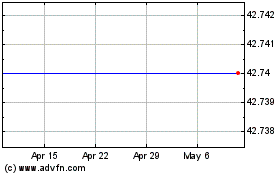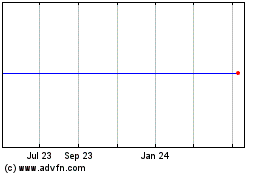Aspen Insurance Holdings Limited (“Aspen”) (NYSE:AHL) announced
today a preliminary estimate of approximately $310 million in
pre-tax losses, net of reinsurance and reinstatement premiums,
related to Hurricanes Harvey, Irma and Maria. Approximately $110
million of these losses are from Hurricane Harvey, $135 million
from Hurricane Irma and $65 million from Hurricane Maria.
In addition, Aspen estimates pre-tax losses, net of reinsurance
and reinstatement premiums, of approximately $50 million from
several other events, the largest of which relate to
weather-related losses and the Mexican earthquakes.
Approximately 75% of the total estimated losses are attributed
to the Reinsurance segment and approximately 25% are attributed to
the Insurance segment.
Aspen expects to record an underwriting loss of approximately
$340 million in the third quarter of 2017. Results for the quarter
reflect the catastrophe losses described above as well as increased
losses in short-tail insurance lines, primarily Property
Insurance.
Aspen’s preliminary estimate of natural catastrophe losses for
the third quarter of 2017 involves the exercise of considerable
judgment and is based, among other factors, on a review of the
individual treaties and policies expected to be impacted,
information available to date from clients and brokers, market
intelligence, initial loss reports, modeled loss projections and
exposure analysis. Due to the complexity of these events and the
uncertainty associated with Aspen’s assumptions and the preliminary
information used to prepare these estimates, Aspen’s actual losses
from these events may differ materially from the estimates provided
above.
Updated loss estimates will be reflected in Aspen’s third
quarter 2017 financial results, which are scheduled for release on
Wednesday, October 25, 2017, following the close of the New York
Stock Exchange.
About Aspen Insurance Holdings Limited
Aspen provides reinsurance and insurance coverage to clients in
various domestic and global markets through wholly-owned
subsidiaries and offices in Australia, Bermuda, Canada, France,
Germany, Ireland, Singapore, Switzerland, the United Arab Emirates,
the United Kingdom and the United States. For the year ended
December 31, 2016, Aspen reported $12.1 billion in total assets,
$5.3 billion in gross reserves, $3.6 billion in total shareholders’
equity and $3.1 billion in gross written premiums. Its operating
subsidiaries have been assigned a rating of “A” by Standard &
Poor’s Financial Services LLC (“S&P”), an “A” (“Excellent”) by
A.M. Best Company Inc. (“A.M. Best”) and an “A2” by Moody’s
Investors Service, Inc. (“Moody’s”).
Application of the Safe Harbor of the Private Securities
Litigation Reform Act of 1995
This press release contains written forward-looking statements,
such as those related to preliminary loss estimates from natural
catastrophes in the third quarter of 2017, which are made pursuant
to the safe harbor provisions of the Private Securities Litigation
Reform Act of 1995. Forward-looking statements include all
statements that do not relate solely to historical or current
facts, and can be identified by the use of words such as “expect,”
“intend,” “plan,” “believe,” “do not believe,” “project,”
“anticipate,” “seek,” “will,” “estimate,” “may,” “likely,”
“continue,” “assume,” “objective,” “aim,” “guidance,” “outlook,”
“trends,” “future,” “could,” “would,” “should,” “target,” “on
track” and similar expressions of a future or forward-looking
nature.
All forward-looking statements rely on a number of assumptions,
estimates and data concerning future results and events and are
subject to a number of uncertainties and other factors, many of
which are outside Aspen’s control that could cause actual results
to differ materially from such statements. Aspen undertakes no
obligation to publicly update or revise any forward-looking
statements, whether as a result of new information, future events
or otherwise. Readers are cautioned not to place undue reliance on
these forward-looking statements, which speak only as of the dates
on which they are made.
All forward-looking statements address matters that involve
risks and uncertainties. Accordingly, there are, or will be,
important factors that could cause actual results to differ
materially from those indicated in these statements. Aspen believes
these factors include, but are not limited to: the actual
development of losses and expenses impacting estimates for
Hurricanes Harvey, Irma and Maria and the earthquakes in Mexico,
that occurred in the third quarter of 2017; the impact of complex
and unique causation and coverage issues associated with the
attribution of losses to wind or flood damage or other perils such
as fire or business interruption relating to such events; potential
uncertainties relating to reinsurance recoveries, reinstatement
premiums and other factors inherent in loss estimation; the
possibility of greater frequency or severity of claims and loss
activity, including as a result of natural or man-made (including
economic and political risks) catastrophic or material loss events,
than our underwriting, reserving, reinsurance purchasing or
investment practices have anticipated; the assumptions and
uncertainties underlying reserve levels that may be impacted by
future payments for settlements of claims and expenses or by other
factors causing adverse or favorable development; the reliability
of, and changes in assumptions to, natural and man-made catastrophe
pricing, accumulation and estimated loss models; the models we use
to assess our exposure to losses from future catastrophes contain
inherent uncertainties and our actual losses may differ
significantly from expectations; our capital models may provide
materially different indications than actual results; evolving
issues with respect to interpretation of coverage after major loss
events; any intervening legislative or governmental action and
changing judicial interpretation and judgments on insurers’
liability to various risks; changes in the total industry losses or
our share of total industry losses resulting from events, such as
catastrophes, that have occurred in prior years or may occur and,
with respect to such events, our reliance on loss reports received
from cedants and loss adjustors; our reliance on industry loss
estimates and those generated by modeling techniques; changes in
rulings on flood damage or other exclusions as a result of
prevailing lawsuits and case law; and the impact of one or more
large losses from events other than catastrophes or by an
unexpected accumulation of attritional losses and deterioration in
loss estimates. For a more detailed description of these
uncertainties and other factors, please see the “Risk Factors”
section in Aspen’s Annual Report on Form 10-K and Aspen’s Quarterly
Reports on Form 10-Q for the quarters ended March 31, 2017 and June
30, 2017 as filed with the United States Securities and Exchange
Commission.
Furthermore, seismic events, such as the Mexico earthquakes,
generally have longer development periods than windstorm events,
which may be amplified in this instance by dynamics such as the
risk of geological liquefaction and the potential for uncertainty
in claims adjudication. In respect of Hurricane Maria, recovery
efforts are ongoing and expanding, with power outages,
infrastructure damage, communications disruptions and other issues
complicating loss mitigation and estimation. Accordingly, our
actual net negative impact from all events noted above, both
individually and in the aggregate, will vary from these preliminary
estimates, perhaps materially.
For further information:
Please visit www.aspen.co
View source
version on businesswire.com: http://www.businesswire.com/news/home/20171016006267/en/
AspenInvestorsMark Jones, 646-289-4945Senior Vice
President, Investor Relationsmark.p.jones@aspen.coorMediaSteve Colton,
+44 20 7184 8337Head of Group CommunicationsSteve.colton@aspen.co
Aspen Insurance (NYSE:AHL)
Historical Stock Chart
From Oct 2024 to Nov 2024

Aspen Insurance (NYSE:AHL)
Historical Stock Chart
From Nov 2023 to Nov 2024
